1995 GMC SIERRA Recommended fluids and lubricants
[x] Cancel search: Recommended fluids and lubricantsPage 337 of 488

Care of Safety Belts
Keep belts clean and dry.
A CAUTION:
Do not bleach or dye safety belts. If you do, it may severely
weaken them. In a crash they might not be able to provide
adequate protection. Clean safety belts only with mild soap and\
lukewarm water.
Glass
Glass should be cleaned often. GM Glass Cleaner (GM Part No. 1050427)
or a liquid household glass cleaner will remove normal tobacco smoke and
dust films.
Don’t use abrasive cleaners
on glass, because they may cause scratches.
Avoid placing decals on the inside rear window, since they may have to be
scraped off later. If abrasive cleaners are used on the inside
of the rear
window, an electric defogger element may be damaged. Any temporary
license should not be attached across the defogger grid.
Cleaning the Outside of the Windshield and
Wiper Blades
If the windshield is not clear after using the windshield washer, or if the
wiper blade chatters when running, wax or other material may be on the
blade or windshield.
Clean the outside of the windshield with GM Windshield Cleaner, Bon-Ami
Powder@ (GM
Part No. 105001 1). The windshield is clean if beads do not
form when
you rinse it with water.
Clean
the blade by wiping vigorously with a cloth soaked in full strength
windshield washer solvent. Then rinse the blade with water.
Wiper blades should be checked
on a regular basis and replaced when worn.
Weatherstrips
Silicone grease on weatherstrips will make them last longer, seal better, and
not stick or squeak. Apply silicone grease with a clean cloth at least every
six months. During very cold, damp weather more frequent application may
be required. (See “Recommended Fluids and Lubricants” in the Index.)
6-71
ProCarManuals.com
Page 358 of 488
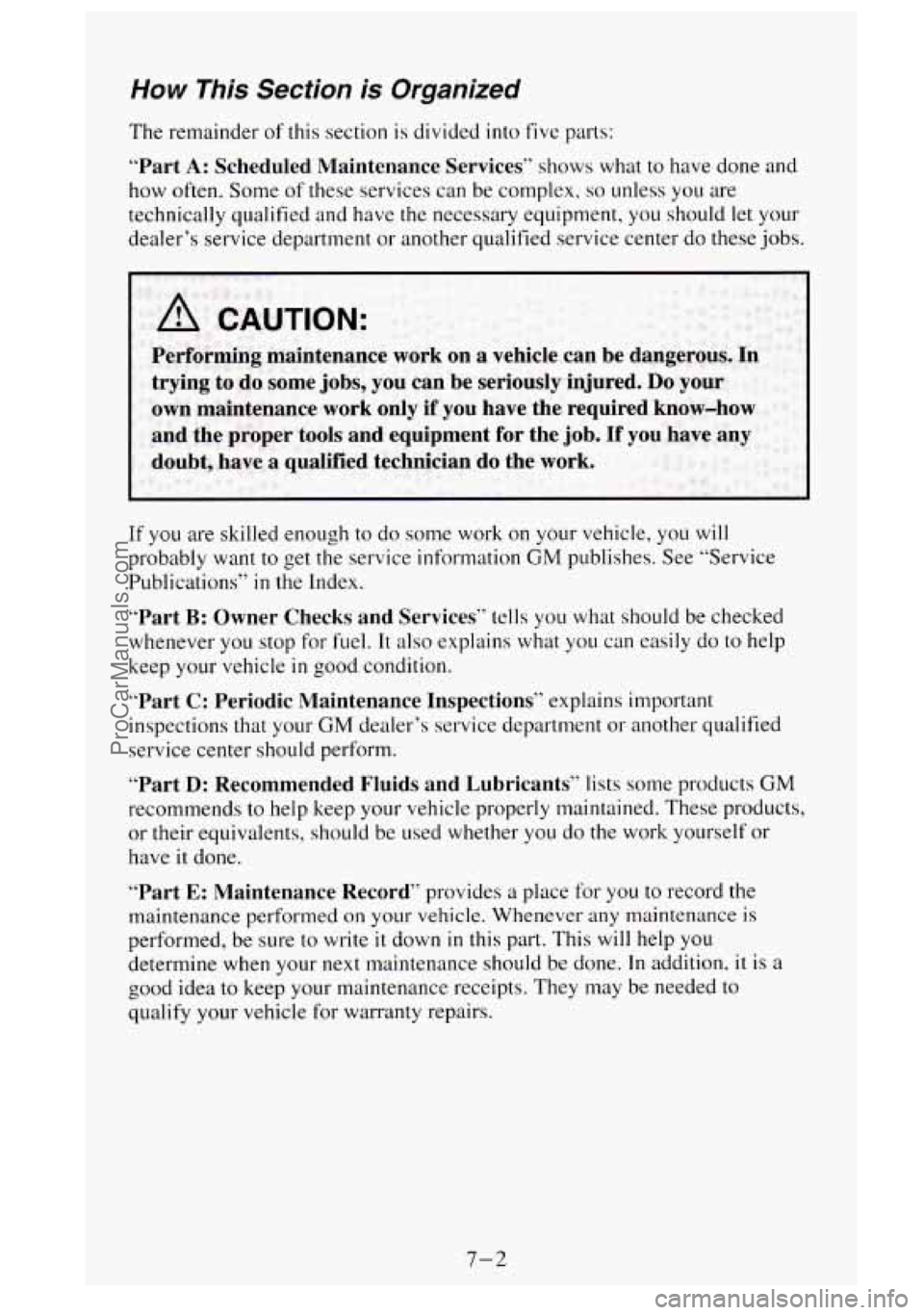
How This Section is Organized
The remainder of this section is divided into five parts:
“Part A: Scheduled Maintenance Services” shows what to have done and
how often. Some
of these services can be complex, so unless you are
technically qualified and have the necessary equipment, you should let your
dealer’s service department or another qualified service center do these
jobs.
If you are skilled enough to do some work on your vehicle, you will
probably want to get the service information
GM publishes. See “Service
Publications”
in the Index.
“Part B: Owner Checks and Services” tells you what should be checked
whenever you stop for fuel.
It also explains what you can easily do to help
keep
your vehicle in good condition.
“Part C: Periodic Maintenance Inspections” explains important
inspections that your
GM dealer’s service department or another qualified
service center should perform.
“Part D: Recommended Fluids and Lubricants” lists some products GM
recommends to help keep your vehicle properly maintained. These products,
or their equivalents, should be used whether you do the work yourself or
have it done.
“Part E: Maintenance Record” provides a place for you to record the
maintenance performed on your vehicle. Whenever any maintenance
is
performed, be sure to write it down in this part. This will help you
determine when your next maintenance should be done.
In addition, it is a
good idea to keep your maintenance receipts. They may be needed to
qualify your vehicle for warranty repairs.
7-2
ProCarManuals.com
Page 359 of 488
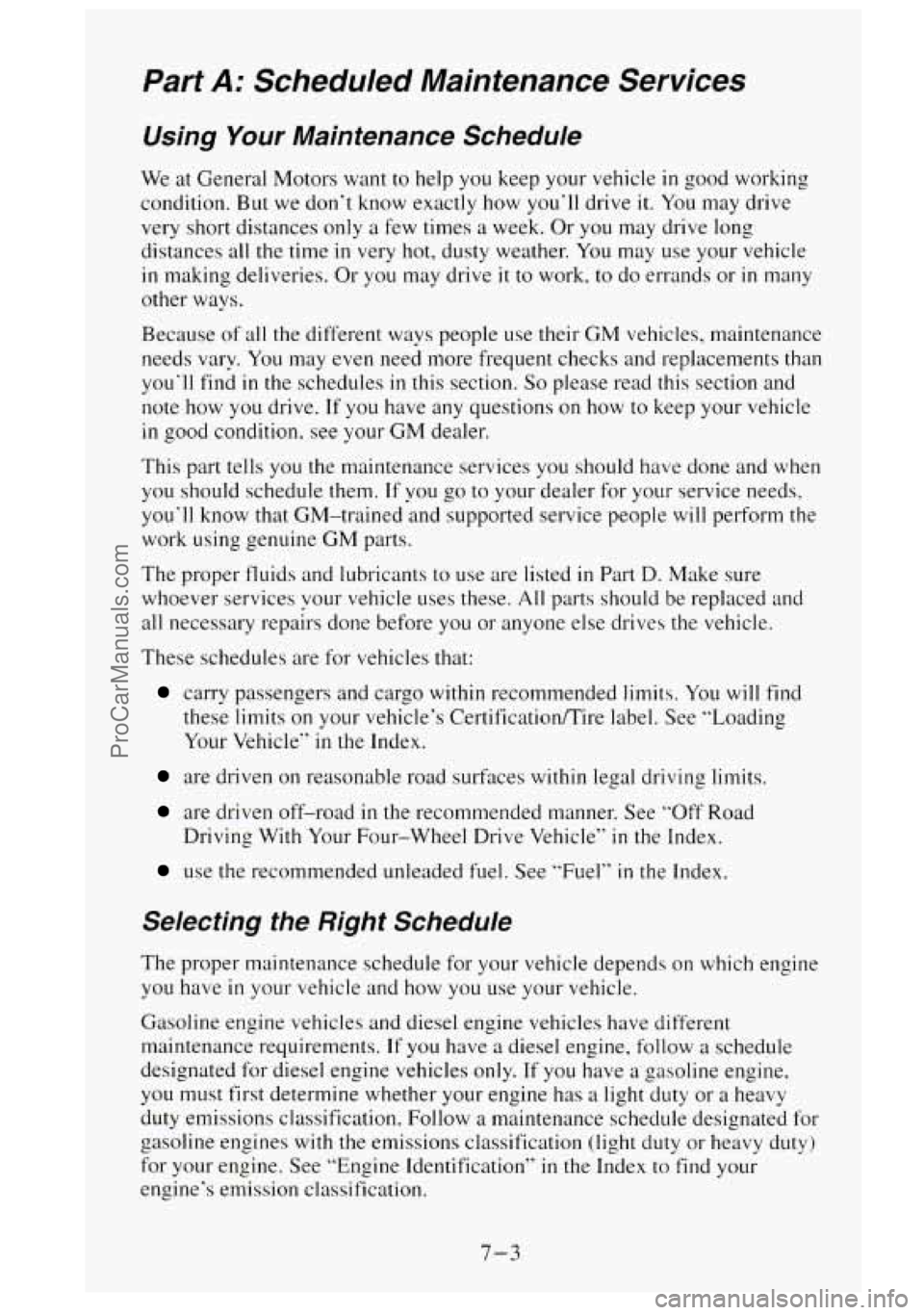
Part A: Scheduled Maintenance Services
Using Your Maintenance Schedule
We at General Motors want to help you keep your vehicle in good working
condition. But we don’t know exactly how you’ll drive it. You may drive
very short distances only
a few times a week. Or you may drive long
distances all the time
in very hot, dusty weather. You may use your vehicle
in making deliveries. Or you may drive it to work, to do errands or in many
other ways.
Because
of all the different ways people use their GM vehicles, maintenance
needs varv.
You may even need more frequent checks and replacements than
you‘ll find
in the schedules in this section. So please read this section and
note how you drive. If you have any questions on how to keep your vehicle
in good condition. see your GM dealer.
This part tells you the maintenance services you should have done and
when
you should schedule them. If you go to your dealer for your service needs,
you’ll know that GM-trained and supported service people
will perform the
work using genuine
GM parts.
The proper fluids and lubricants to use are listed
in Part D. Make sure
whoever services your vehicle uses these.
All parts should be replaced and
all necessary repairs done before you or anyone else drives the vehicle.
These schedules are for vehicles that:
carry passengers and cargo within recommended limits. You will find
these limits on your vehicle’s CertificatiodTire label. See “Loading
Your Vehicle“
in the Index.
are driven on reasonable road surfxes within legal driving limits.
are driven off-road in the recommended manner. See “Off Road
Driving With Your Four-wheel Drive Vehicle”
in the Index.
use the recommended unleaded fuel. See “Fuel” in the index.
Selecting the Right Schedule
The proper maintenance schedule for your vehicle depends on which engine
you have
in your vehicle and how you use your vehicle.
Gasoline engine vehicles and diesel engine vehicles have different
maintenance requirements.
If you have a diesel engine, follow a schedule
designated for diesel engine vehicles only. If you have
a gasoline engine.
you must first determine whether your engine has
a light duty or a heavy
duty emissions classification. Follow a maintenance schedule designated
for
for your engine. See “Engine Identification” in the Index to find your
engine‘s emission classification.
c easoline engines with the emissions classification (light duty or heavy duty)
7-3
ProCarManuals.com
Page 368 of 488
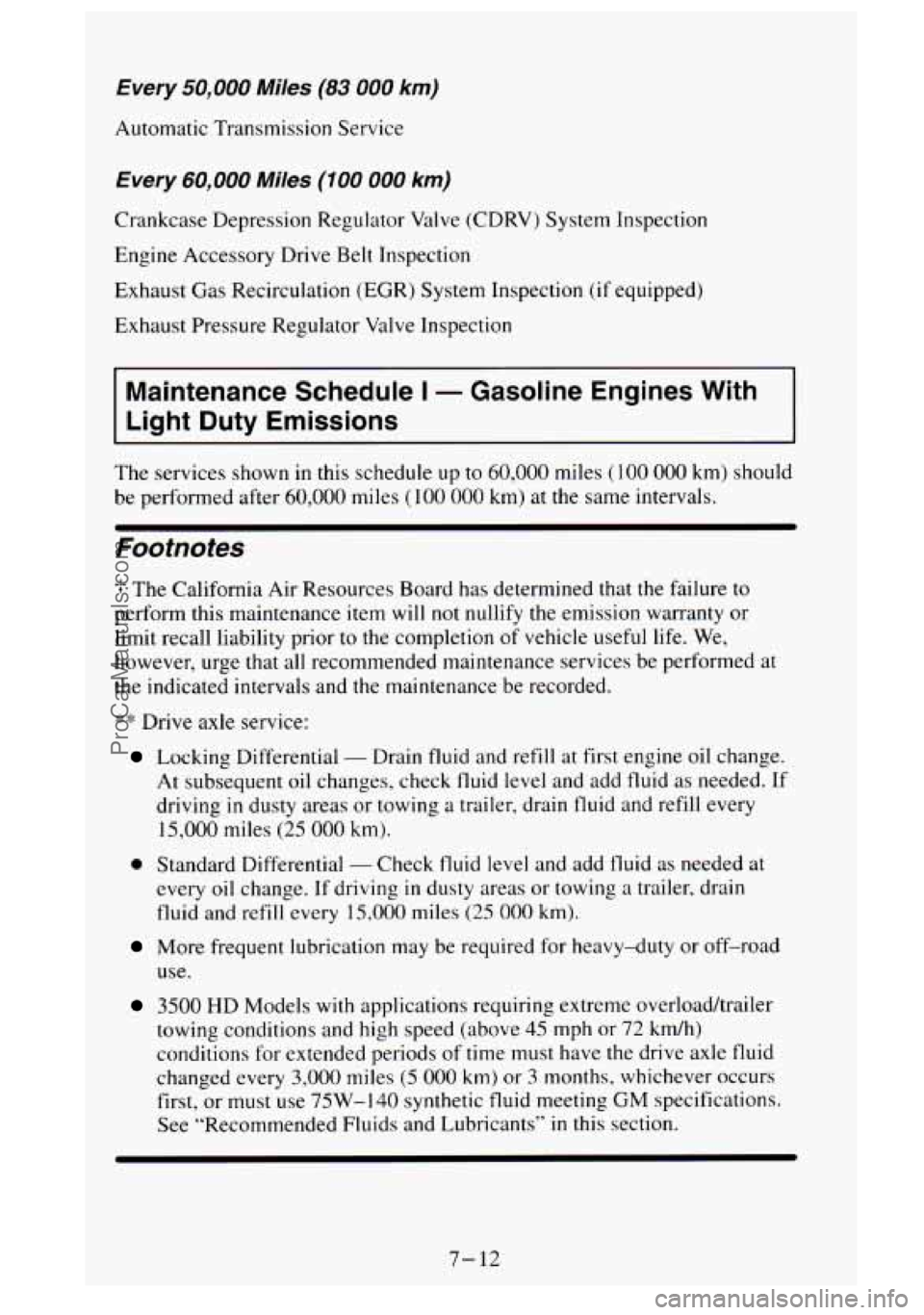
Every 50,000 Miles (83 000 km)
Automatic Transmission Service
Every 60,000 Miles (100 000 km)
Crankcase Depression Regulator Valve (CDRV) System Inspection
Engine Accessory Drive Belt Inspection
Exhaust Gas Recirculation (EGR) System Inspection
(if equipped)
Exhaust Pressure Regulator Valve Inspection
Maintenance Schedule I - Gasoline Engines With
Light
Duty Emissions
The services shown in this schedule up to 60,000 miles (1 00 000 km) should
be performed after
60,000 miles (100 000 km) at the same intervals.
Footnotes
3 The California Air Resources Board has determined that the failure to
perform this maintenance item will not nullify the emission warranty or
limit recall liability prior to the completion of vehicle useful life. We,
however, urge that all recommended maintenance services be performed at
the indicated intervals and the maintenance be recorded.
:$* Drive axle service:
Locking Differential - Drain fluid and refill at first engine oil change.
At subsequent oil changes, check fluid level and add fluid
as needed. If
driving in dusty areas or towing a trailer, drain fluid and refill every
15,000 miles (25 000 km).
0 Standard Differential - Check fluid level and add fluid as needed at
every oil change.
If driving in dusty areas or towing a trailer, drain
fluid and refill every 15,000 miles (25 000 km).
More frequent lubrication may be required for heavy-duty or off-road
use.
3500 HD Models with applications requiring extreme overload/trailer
towing conditions and high speed (above
45 mph or 72 kmh)
conditions for extended periods of time must have the drive axle fluid
changed every
3,000 miles (5 000 km) or 3 months, whichever occurs
first, or must use
75W-140 synthetic fluid meeting GM specifications.
See “Recommended Fluids and Lubricants”
in this section.
7-12
ProCarManuals.com
Page 383 of 488
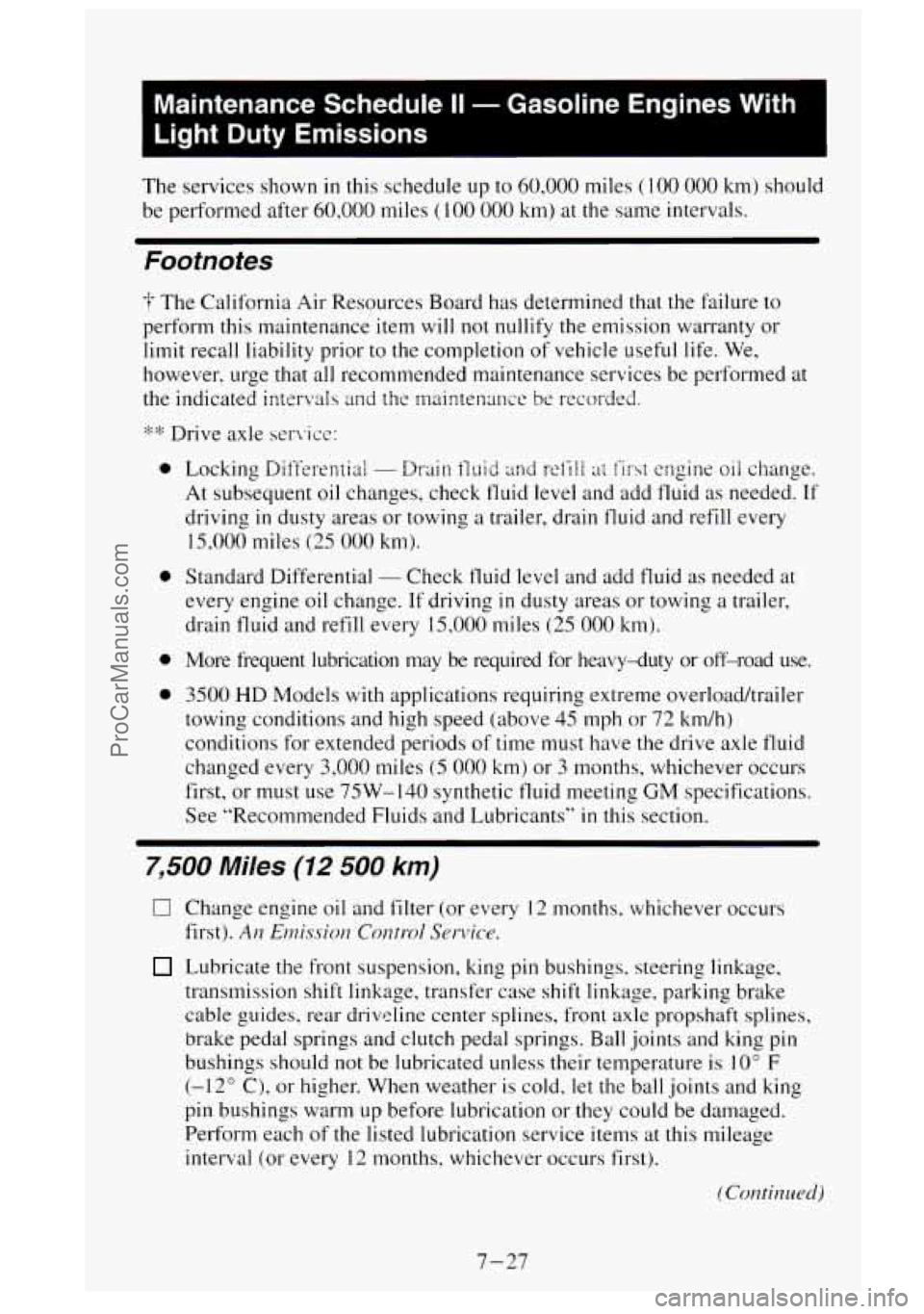
Maintenance Schedule II - Gasoline Engines With
Light Duty Emissions
The services shown in this schedule up to 60.000 miles ( 100 000 km) should
be performed after
60.000 miles ( 100 000 km) at the same intervals.
Footnotes
-i- The California Air Resources Board has determined that the Failure to
perform this maintenance item will
not nullify the emission warranty or
limit recall liability prior
to the completion of vehicle useful life. We,
however. urge that all recommended maintenance services be performed at
the indicated intsrkrds
and t!w rnlrinlcn;nnx be recor-ded.
0
0
0
0
Locking Differential - Drain iluid mci wi.il! :ii !.iI-st cngine oii change.
At subsequent oil changes, check fluid level and add fluid as needed. If
driving in dusty areas or towing a trailer. drain fluid and refill every
15,000 miles
(25 000 km).
Standard Differential - Check tluid level and add fluid as needed at
every engine
oil change. If--driving in dusty areas or towing a trailer.
drain fluid and refill every
15,000 miles (25 000 km).
More frequent lubrication may be required for heavy-duty or off\
-road use.
3500 HD Models with applications requiring extreme overload/trailer
towing conditions and high speed (above
45 mph or 72 km/h)
conditions for extended periods
of time must have the drive axle fluid
changed every
3,000 miles (5 000 km) or 3 months, whichever occurs
first, or must use 7SW-140 synthetic tluid meeting
GM specifications.
See "Recommended Fluids and Lubricants"
in this section.
7,500 Miles (12 500 km)
0 Change engine oil and filter (or every 12 months. whichever occurs
first).
A11 E1?7iLs.~io1I Corlti-ol Serl7ic-e.
Lubricate the front suspension, king pin bushings. steering linkage,
transmission shift linkage, transfer case shift linkage. parking brake
cable guides.
rear driveline center splines, front axle propshaft splines,
brake pedal springs and clutch pedal springs.
Ball joints and king pin
bushings should
not be lubricated unless their temperature is 10" F
(-12" C). or higher. When weather is cold, let the ball joints and king
pin bushings warm up before lubrication or they could be damaged.
Perform each of the listed lubrication service items at this mileage
interval (or every
12 months. whichever occurs first).
(ColltillltL'd)
7-27
ProCarManuals.com
Page 390 of 488

I
Maintenance Schedule II - Gasoline Engines With
Light Duty Emissions
0 Replace spark plugs. At1 Emission Control Senlice.
0 Inspect spark plug wires. Ai7 Emission Control Service. ;
0 Replace air cleaner filter. An E~~zission Control Sunice.
-
r! Inspect fuel tank, cap and lines for damage or leaks. Inspect fuel cap
gasket for any damage. Replace parts
as needed. An E~nission Control
Service. ?
DATE
SERVICED BY: ACTUAL MILEAGE I
<
Maintenance Schedule I - Gasoline Engines Heavy
Duty Emissions
The services shown in this schedule up to 60.000 miles ( 100 000 km) should
be performed after
60.000 miles (100 000 km) at the same intervals.
Footnotes
*<: Drive axle service:
a
a
0
a
Locking Differential - Drain fluid and refill at first engine oil change.
At subsequent oil changes, check fluid level and add fluid as needed.
If
driving in dusty areas or towing a trailer, drain fluid and refill every
15,000 miles
(25 000 km).
Standard Differential
- Check fluid level and add fluid as needed at
every engine oil change.
If driving in dusty areas or towing a trailer,
drain fluid and refill every
15,000 miles (25 00 km).
More frequent lubrication may be required for heavy-duty or off-road
use.
3500 HD Models with applications requiring extreme overload/trailer
towing conditions and high speed (above
45 mph or 72 km/h)
conditions for extended periods of time must have the drive axle fluid
changed every
3,000 miles (5 000 km) or 3 months, whichever occurs
first, or must use
75W-140 synthetic fluid meeting GM specifications.
See “Recommended Fluids and Lubricants”
in this section.
7-34
ProCarManuals.com
Page 408 of 488

Maintenance Schedule I - Gasoline Engines Heavy
Duty Emissions
(Continued)
L! If your engine has a thermostatically controlled cooling fan, inspect all
hoses and ducts for proper hook-up (or every 12 months, whichever
occurs first).
Be sure the valve works properly. This is a Noise
Emission Control Service. Applicable only to vehicles sold in the
United States.
DATE SERVICED BY: ACTUAL MILEAGE 1 I
Maintenance Schedule II - Gasoline Engines With
Heavy Duty Emissions
The services shown in this schedule up to 60.000 miles ( 100 000 kn1) should
be performed after
60.000 miles ( IO0 000 km) at the same intervals.
Footnotes
.I, .!. -~*-~- Drive axle service:
0 Locking Differential - Drain fluid and refill at first engine oil change.
At subsequent
oil changes. check fluid and add fluid as needed. If
driving in dusty areas or towing a trailer, drain fluid and refill every
15,000 miles (25 000 km).
0 Standard Differential - Check fluid level and add fluid as needed at
every engine oil change. If driving in dusty areas or towing a trailer,
drain fluid and refill every 15,000 miles
(25 000 km).
0 More frequent lubrication may be required for heavy-duty or off-road
use.
0 3500 HD Models with applications requiring extreme overload/trailer
towing conditions and high speed (above 45
mph or 72 km/h)
conditions for extended periods of time must have the drive axle fluid
changed every 3.000 miles
(5 000 km) or 3 months, whichever occurs
first, or rnust use 75W-140 synthetic tluid meeting
GM specifications.
See "Recommended Fluids and Lubricants"
in this section.
7-52
ProCarManuals.com
Page 418 of 488
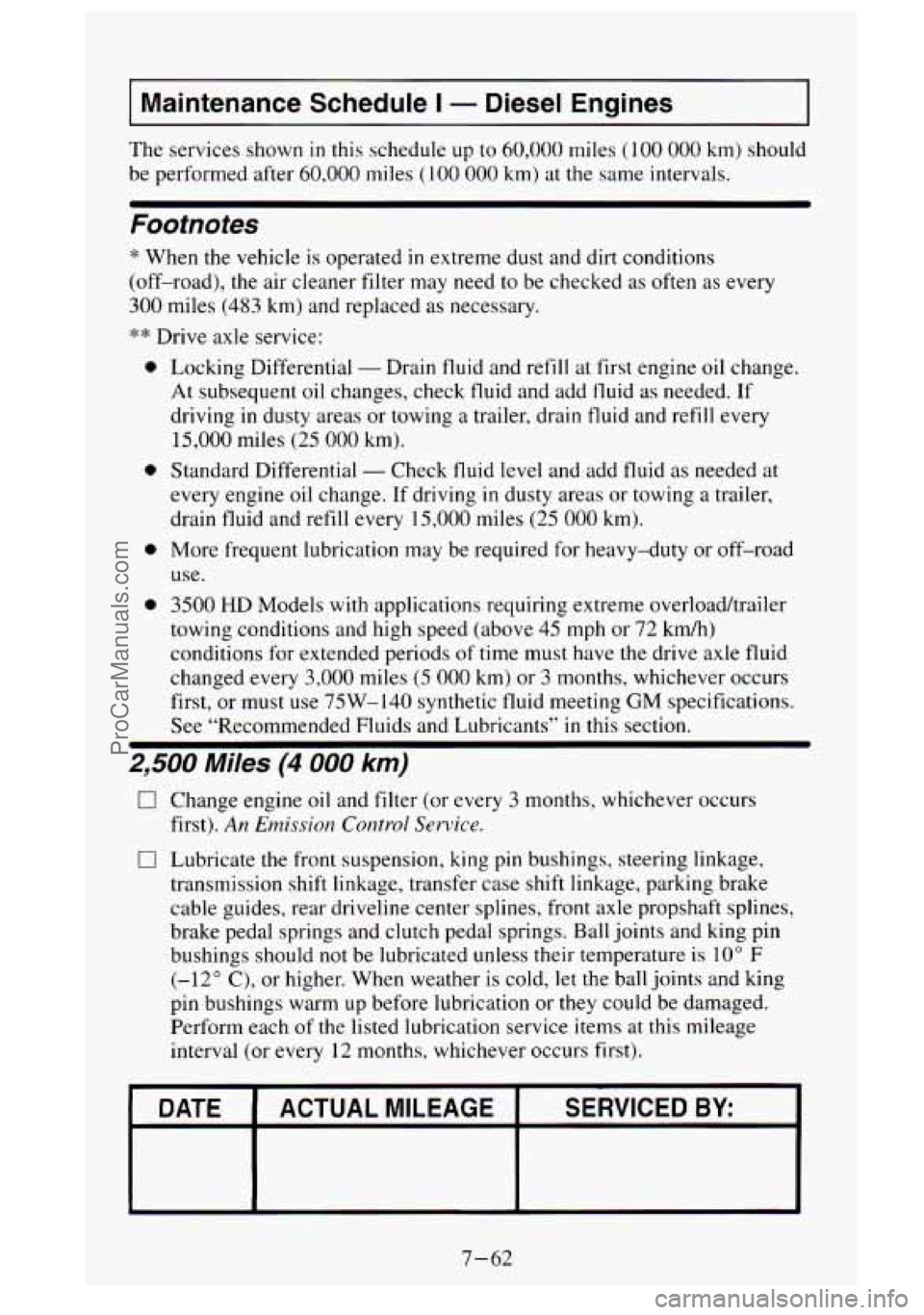
Maintenance Schedule I - Diesel Engines
The services shown in this schedule up to 60,000 miles (100 000 km) should
be performed after
60,000 miles (100 000 km) at the same intervals.
Footnotes
* When the vehicle is operated in extreme dust and dirt conditions
(off-road), the air cleaner filter may need to be checked as often
as every
300 miles (483 km) and replaced as necessary.
** Drive axle service:
0
0
0
0
Locking Differential - Drain fluid and refill at first engine oil change.
At subsequent oil changes, check fluid and add fluid
as needed. If
driving
in dusty areas or towing a trailer, drain fluid and refill every
15,000 miles (25
000 km).
Standard Differential
- Check fluid level and add fluid as needed at
every engine oil change. If driving
in dusty areas or towing a trailer,
drain fluid and refill every 15,000 miles
(25 000 km).
More frequent lubrication may be required for heavy-duty or off-road
use.
3500 HD Models with applications requiring extreme overload/trailer
towing conditions and high speed (above
45 mph or 72 km/h)
conditions for extended periods of time must have the drive axle fluid
changed every
3,000 miles (5 000 km) or 3 months, whichever occurs
first, or must use 75W-140 synthetic fluid meeting
GM specifications.
See “Recommended Fluids and Lubricants’’
in this section.
2,500 Miles (4 000 km)
0 Change engine oil and filter (or every 3 months, whichever occurs
first).
An Emission Control Service.
0 Lubricate the front suspension, king pin bushings, steering linkage,
transmission shift linkage, transfer case
shift linkage, parking brake
cable guides, rear driveline center splines, front axle propshaft splines,
brake pedal springs and clutch pedal springs. Ball joints and king pin
bushings should not be lubricated unless their temperature
is 10” F
(-12” C), or higher. When weather is cold, let the ball joints and king
pin bushings warm up before lubrication or they could be damaged.
Perform each of the listed lubrication service items at this mileage
interval (or every 12 months, whichever occurs first).
DATE SERVICED BY: ACTUAL MILEAGE I
7-62
ProCarManuals.com